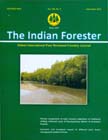Genetic Diversity in Dalbergia sissoo Roxb. Through Molecular Markers for Practical Applications
DOI:
https://doi.org/10.36808/if/2012/v138i9/21801Keywords:
Dalbergia Sissoo, Rapd, Genetic Diversity, Polymorphism And HeterosisAbstract
The tree improvement programme of Dalbergia sissoo Roxb. was started by selecting about 300 plus trees from the distribution range by adopting index method of selection. The selected plus trees were cloned through root suckers and single nodal cuttings rooted both in mist and mist-less chamber. Genetic diversity of further selected forty nine clones was tested through DNA based molecular marker. A total of thirty decamer random amplified polymorphic DNA (RAPD) primers initially screened which were later reduced to ten most informative primers for the evaluation of level of genetic diversity. The primers generated 129 reproducible RAPD bands with fragments ranging from 200 to 1300 base pairs, of which 110 were polymorphic. The polymorphic information content (PIC) among the clones varied from 0.154 (M-33) to 0.258 (M-122) to witness that RAPD primers detected genetic diversity among the clones. The highest polymorphism (93.33 %) was reported with primer OPAG-16 and the lowest (63.63 %) with primer OPAF-16. Nonetheless, the average polymorphism with ten primers was calculated to 84.93 %. The studies would play a complementary role in hybridization, when selection of most divergent parents becomes supreme importance to harness maximum heterosis in the shortest possible time.Downloads
Download data is not yet available.
Downloads
Published
2012-09-01
How to Cite
Dobhal, S., Kumar, A., & Sharma, S. (2012). Genetic Diversity in <I>Dalbergia sissoo</I> Roxb. Through Molecular Markers for Practical Applications. Indian Forester, 138(9), 819–821. https://doi.org/10.36808/if/2012/v138i9/21801
Issue
Section
Articles
License
Unless otherwise stated, copyright or similar rights in all materials presented on the site, including graphical images, are owned by Indian Forester.





